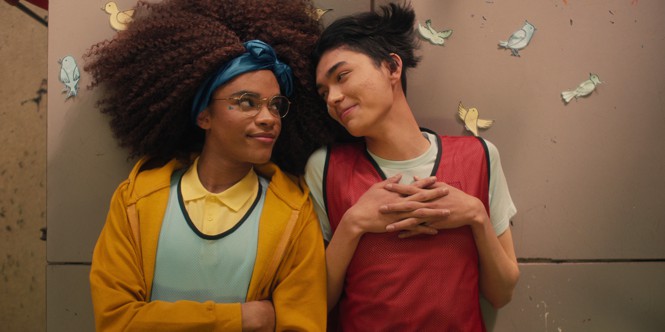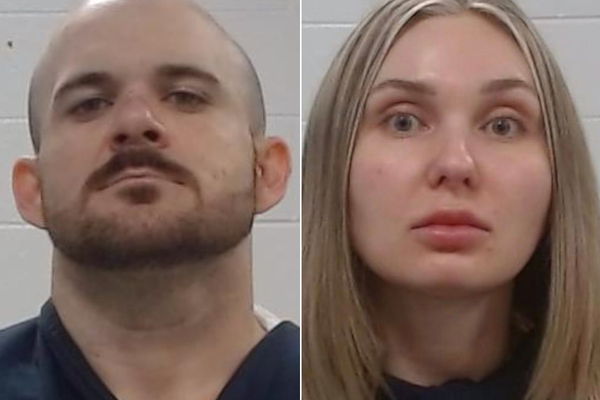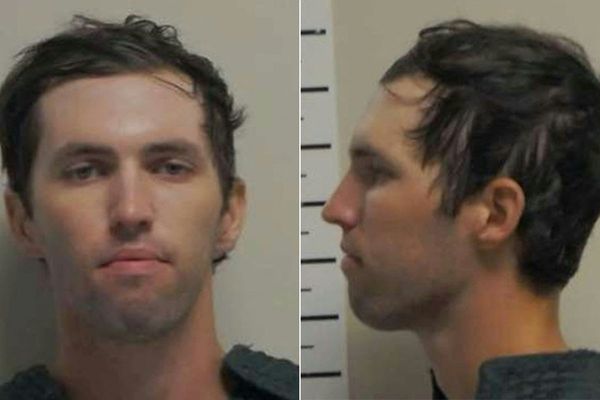
When the producer Patrick Walters first read the romance comic Heartstopper, he knew it had to be a TV show. There was something about the way the author, Alice Oseman, had illustrated the story that gave him “butterflies,” he told me over Zoom. The characters—a pair of teen boys falling in love—were adorably expressive, all wide eyes and furtive glances captured in fine strokes. Their dialogue felt realistic; as a young-adult novelist who published her first book while in college, Oseman had a knack for adolescent language, online and off. And her 15-year-old protagonist, Charlie, was openly gay, which meant the plot didn’t begin with the character agonizing over his sexuality. “He is sure of himself, so we’re not coming in via the usual route of the queer coming-out story,” Walters said. “That was really refreshing to me.”
Mainstream coming-of-age stories about LGBTQ teenagers don’t normally look like Charlie’s. These works tend to treat coming out as the core emotional conflict, portraying the experience as an internal crisis rife with secret keeping and anxiety. But Netflix’s popular adaptation of Heartstopper shifts the focus, prioritizing the depiction of celebration over that of repression—and it’s not the only recent, widely accessible project to do so. On Hulu, the romantic comedy Crush breezes past the question of its heroine’s queerness in the film’s first five minutes. And when Love, Victor—the spin-off series to the 2018 film Love, Simon—returns for its final season next month, it’ll move fully beyond the coming-out journey that’s defined the story (and the movie that inspired it) thus far. This change made the show “a lot more fun to write,” the Love, Victor co-showrunner Brian Tanen told me. “I was always very hopeful that the coming out could happen sooner rather than later, so that we could get on with the fun part.”
[Read: Love, Simon is groundbreakingly ordinary]
The fun part being teenagehood, of course—that of first crushes, first kisses, first flings—the kind of swoon-worthy milestones that straight characters have enjoyed without the baggage of having to define their sexuality. Reframing the queer coming-of-age experience as, simply, coming-of-age may seem like a subtle shift, but it helps illuminate how the emphasis on coming out has perhaps limited queer storytelling.
As my colleague Spencer Kornhaber observed in 2018 of the wave of indie films about queer teenagers, including Call Me By Your Name and Boy Erased, “It’s curious that in an age of unprecedented visibility for LGBTQ communities, the queer teens chosen for the cinematic spotlight appear so allergic to, well, seeming gay … Whether the implied assimilationist impulse reflects the filmmakers’ or the characters’ caution is up for debate.” Either way, coming-out stories tend to be told with straight audiences in mind. As Raina Deerwater, the entertainment-research-and-analysis manager at GLAAD Media Institute, told me, the drama and suspense of such arcs tend to highlight and hinge on “straight people reacting as opposed to what a queer person’s journey is.”
According to the sociologist Mary Robertson, a lecturer at Seattle University, shows that minimize the trials of coming out can better reflect regular life for queer teenagers. In her research for her book, Growing Up Queer: Kids and the Remaking of LGBTQ Identity, Robertson worked with an LGBTQ youth center, speaking with teenagers who pointed out that “being gay wasn’t always their biggest problem,” she told me. If the gay-rights movement initially emphasized narratives about pride and learning to embrace one’s sexual identity rather than hiding it, today’s teenagers look for more varied depictions of queer life. Stories that continue to stress the burden of coming out have largely stopped being representative; they reinforce the idea that “if you’re different, you have to come out and explain yourself,” Robertson said.
Kirsten King and Casey Rackham, the writers of Crush, approached the coming-out question from that exact point of view. To them, spending a significant portion of their rom-com explaining why the protagonist, Paige (Rowan Blanchard), is attracted to women felt like capitulating to a straight audience used to seeing, as King puts it, “a little bit of that trauma” in films about queer characters. Instead, “we wanted to do what straight people have gotten for decades,” Rackham told me. That is, they just wanted characters “to have a meet-cute and then have a miscommunication that would be solved if they had a conversation with each other.”

The film thus speeds through Paige’s coming out: In a flashback, she tells her mother, who instantly accepts her daughter’s identity. King concedes that the beat may seem unrealistic for teenagers living in less-welcoming households, but she felt that the positive tone could be helpful for viewers who have never been able to indulge in such experiences—just as rom-coms about straight couples provide fantasies for their audiences. “When I first came out to my mom, she was more supportive than other people in my family, but her biggest fear was, ‘It just seems like it’s going to be so hard for you’ … She couldn’t imagine a future where I was happy and fulfilled and safe,” she explained. “And so I think giving people that image, to help them imagine a future where queer people are safe and have love stories just like straight people do—that was a big motivation.”
[Read: The changing ways parents react to their kids coming out of the closet]
Heartstopper, meanwhile, does incorporate a coming-out arc, but it isn’t the show’s central conflict. When Charlie (played by Joe Locke) develops an interest in his classmate Nick (Kit Connor), he’s uncertain whether Nick is interested in men. Given that Nick has never defined his sexuality, the characters end up embarking on the journey together. Nick has questions he hopes Charlie can answer, while Charlie, in turn, becomes more open; the two help each other mature emotionally through their relationship as it develops from friendship into something more. Deerwater explained that framing a coming-out story in this way felt true to life. “It is not just about one queer person existing in a straight world,” she said of Nick and Charlie’s bond. “Most people I personally know and that you see in the LGBTQ community, they aren’t the only ones. There’s a whole group of people surrounding them.”
Crucially, the story of Nick and Charlie is sweet but not saccharine—the pair stumble on the way to becoming a couple, because adolescence is a minefield of heady emotions and dating mishaps—and Nick’s coming out is characterized less by fear than by curiosity. In a sly bit of meta commentary, he searches on the internet for films he could watch about the LGBTQ experience as he begins to feel attracted to Charlie. The list he lands on recommends Brokeback Mountain and Moonlight, but rather than watching either, Nick indulges in an old favorite, Pirates of the Caribbean.
During a scene featuring Keira Knightley and Orlando Bloom, he realizes he’s into both actors. Oseman, who wrote every episode, added the moment, which wasn’t in the original comic, after asking her Twitter followers for their favorite movies that made them “feel extra bi.” Most people responded not with titles from the queer-cinema canon but with Hollywood blockbusters that showed how the community has long projected itself onto straight stories. If many people in real life had been learning about their sexuality in another way, the show didn’t need Nick to watch movies, however excellent or prestigious, that involved queer characters suffering, Walters explained. “Because that scene is supposed to be celebratory of this new identity that’s kind of coming slowly into Nick’s mind,” he said, Pirates of the Caribbean is “the perfect [film to watch], rather than something that’s a bit more tortured.”
[Read: The shadow that queerbaiting casts on gay romance]
In both Heartstopper and Crush, the relationships matter more than the sexual identities of the protagonists. Instead of stressing out about coming out, these teenagers wonder about how to get closer to the object of their affection. And they worry about being liked back by that one person, instead of worrying on-screen about being embraced by all of society. Even in the growing landscape of hit projects involving queer teens, such as Sex Education and Never Have I Ever, these story arcs are rare. They’re normally relegated to supporting characters, who spend episodes, if not entire seasons, questioning their sexuality before they get to embark on actual romances. When queer characters are the protagonists, as in a show like Euphoria, their stories sometimes traffic in tropes that underline pain and isolation, shrouding their experiences in negativity for the sake of drama. “These narratives have in the past been centered around LGBTQ+ people’s trauma or their sense of not knowing who they are, and then having to make a decision that sometimes doesn’t come from them but comes from the world that’s outside of them,” Walters said. “To show feelings just blossom and mature and go at a character’s own pace in a universal way is, I hope, the power of the show.”
As a result, watching Heartstopper and Crush can feel like watching versions of whimsical queer utopias. Both limit the role of homophobic bullying; in Heartstopper, a classmate regularly insults Charlie, but because Charlie has sturdy support in Nick and a circle of friends, dealing with taunts isn’t his main concern. Both feature an array of queer teens, so the protagonists aren’t the only ones on screen; in Crush, Paige has so many possible love interests that the film uses a cheeky montage to outline each of their potential benefits. And both projects use artful flourishes to underline the thrill of teen romance: In Paige’s eyes, the girl she likes walks in slow motion while bursts of color fill the frame; Charlie sees Nick awash in a soft-pink glow as he starts to fall in love. Such fantastical elements remind queer-teen audiences that being queer doesn’t have to mean hardship. It can mean magic. After all, King explained, getting to write a queer coming-of-age story for a queer-teen audience is a rare opportunity for wish fulfillment. “When you’re writing something, at least for me, it’s like, you’re writing the world you want to see,” she said. “Why not make it exactly how you want it?”







